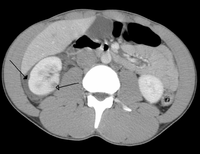
Photo from wikipedia
A prospective evaluation of Selective Nonoperative Management of Abdominal Stab Wounds. Observation for a minimum of 24 hours is warranted prior to discharge. #TraumaSurg #WTA2022 BACKGROUND The optimal observation time… Click to show full abstract
A prospective evaluation of Selective Nonoperative Management of Abdominal Stab Wounds. Observation for a minimum of 24 hours is warranted prior to discharge. #TraumaSurg #WTA2022 BACKGROUND The optimal observation time required to exclude hollow viscus injury in patients undergoing selective nonoperative management (SNOM) for abdominal stab wounds (SWs) remains unclear. The aim of this study was to determine the safe period of observation required before discharge. METHODS In this prospective observational study, all patients who sustained an abdominal SW were screened for study inclusion (July 2018 to May 2021). The primary study outcome was time to SNOM failure, defined as the need for surgical intervention after an initial period of observation. RESULTS During the study period, 256 consecutive patients with an abdominal SW met the study criteria. The mean age was 33 (26–46) years, and 89% were male. Of all patients, 77% had single SW, and 154 (60%) had an anterior abdominal SW (most common site right upper quadrant, 31%). Forty-six (18%) underwent immediate laparotomy because of evisceration (59%), hemodynamic instability (33%), or peritonitis (24%). The remaining 210 patients (82%) were taken for computed tomography scan (n = 208 [99%]) or underwent clinical observation only (n = 2 [<1%]). Of the patients undergoing computed tomography scan, 27 (13%) triggered operative intervention, and 9 (4%) triggered angioembolization. The remaining 174 patients (83%) underwent SNOM. Of these, three patients (2%) failed SNOM and underwent laparotomy: two developed peritonitis at 10 and 20 hours after arrival, respectively, and at laparotomy had small bowel and gastric injuries. The third patient developed increasing leukocytosis but had nontherapeutic laparotomy. CONCLUSION Selective nonoperative management of stab wounds to the abdomen commonly avoids nontherapeutic operative intervention and its resultant complications. A small percentage of patients will fail SNOM, and therefore, close clinical observation of these patients in hospital is critical. All patients in this series who failed SNOM did so within 24 hours of presentation. Therefore, we recommend a period of 24 hours of close clinical monitoring to exclude a hollow viscus injury before discharge of patients with abdominal stab wounds who do not meet the criteria for immediate operative intervention. LEVEL OF EVIDENCE Prognostic/Epidemiological; Level III.
Journal Title: Journal of Trauma and Acute Care Surgery
Year Published: 2022
Link to full text (if available)
Share on Social Media: Sign Up to like & get
recommendations!